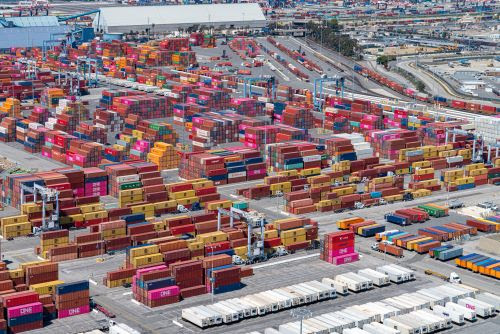
Second-busiest October achieved at Port of Long Beach
Capacity limits hamper cargo flow as Port works to lessen the backlog
Limited capacity at marine terminals hampered imports at the Port of Long Beach last month, although volumes were still strong enough to mark the Port’s second-busiest October amid an ongoing transition to extended operating hours.
Dockworkers and terminal operators moved 789,716 twenty-foot equivalent units (TEUs), down 2.1% from the Port’s strongest October on record, achieved in 2020. Imports decreased 4.3% to 385,000 TEUs, while exports increased 6.6% to 122,214 TEUs. Empty containers moved through the Port declined 2.4% to 282,502 TEUs.

Mario Cordero
“Every sector of the supply chain has reached capacity and it is time for all of us to step up and get these goods delivered,” said Port of Long Beach Executive Director Mario Cordero. “In Long Beach, we are trying to add capacity by searching for vacant land to store containers, expanding the hours of operation at terminals, and implementing a fee that will incentivize ocean carriers to pull their containers out of the Port as soon as possible.”

Harbor Commissioner Steven Neal
“We are working around the clock at the Port,” said Long Beach Harbor Commission President Steven Neal. “We’re doing everything we can with help from the supply chain to get goods off the ships and onto store shelves in time for the holidays.”
The Port of Long Beach enacted a Congestion Dwell Fee on Nov. 1, charging ocean carriers for cargo containers that remain too long on the docks. The program is aimed at speeding the flow of cargo containers moving through the San Pedro Bay ports complex and reducing the record number of vessels waiting off the Southern California coast. As of Nov. 10, there has been a 20% decrease in loaded import containers that have dwelled at the Port of Long Beach past their respective time limits. The Port of Los Angeles has adopted an identical measure.
Additionally, the Port continues to work with marine terminals and other supply chain partners to expand hours as part of a framework for 24-7 operations.
Consumer spending slightly lagged in early fall but remains above pre-pandemic levels. Employment is rebounding more quickly than the periods following the dot-com bust and the Great Recession, with full jobs recovery anticipated by mid-2022.
The Port of Long Beach has moved 7,884,565 TEUs during the first 10 months of 2021, up 21% from the same period in 2020. The Port is on pace to move more than 9 million TEUs by the end of this year, surpassing the current record of 8.1 million TEUs achieved in 2020.
For complete cargo numbers, visit polb.com/statistics. For reports on ships at anchor and berth, as well as import containers dwelling past nine days, visit polb.com/operations.









